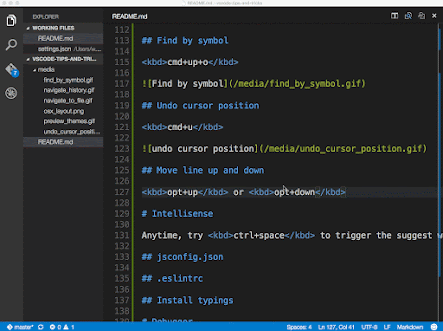

Consider this for a moment.ĭo you think it is okay if someone repeatedly selects text by dragging through the mouse and selecting the cut option from the menu for once instead of pressing Ctrl+X? or by holding down the mouse button to copy the entire text instead of pressing Ctrl+A?
#VS CODE SHORTCUTS FOR CMD TERMINAL HOW TO#
It’s also possible to verify the usage of the shortcuts via the Keyboard Shortcuts UI which allows us to record keys to find the definition of the shortcut associated with the key combination.It is possible to become more efficacious and proficient with any tool when you know how to use shortcuts. Note that we specify "when": "textInputFocus" so that the shortcut is only available when the editor focus is on a text input. CMD+DOWNmove the cursor by 5 lines down.This would then replace the current CMD+UP and CMD+DOWN to: Place your key bindings in this file to override the defaultsauto CMD+SHIFT+P > open keyboard shortcuts (JSON).This can be done by adding our own mapping via: Navigating down without a mouse scroll becomes a pain as to go to the middle of the screen, we would either need to hit CTRL+G > 50 to go to line 50 or hit DOWN and waiting a considerable amount of time until the cursor moves to line 50.Īnother way is to setup custom keyboard bindings which would move the cursor skipping lines five by five which would accelerate the movement of the cursor to the desired line, and when we get close to line 50, we can then use the regular DOWN arrow. With screens having larger and larger resolutions, we are able to display hundred lines on a monitor. CTRL+SHIFT+UP/DOWN select multiline for editing.
 CMD+ALT+UP/DOWN select multiline for editing. Lastly management of the file being edited: There are also problem management shortcuts, allowing us to quickly see which line of code is causing a problem: CTRL+ALT+- go back to previous cursor, useful when using F12. CMD+F12 for language like C#, go to abstraction implementation, if multiple one available show in peek. SHFT+F12 show all references, on types would be references within the project, on variable will be references within the scope where the variable is available. CTRL+SHIFT+- go forward cursor, same useful when using CTRL+. CTR+- go back to previous cursor, useful when using F12. Then some shortcuts to work with Codelens, looking at definition, or implementation (in OOP languages): ALT+ARROW change terminal focus (depending on terminal panel orientation). To close the terminal, type exit (if you are using bash). CMD+ALT+ARROW change terminal focus (depending on terminal panel orientation). CTRL+1/2/3/n open a separate editor group or focus editor group if existing. CTRL+P > CTRL+ENTER go to file > open in separate editor group. CMD+SHIFT+E focus on file explorer on side bar, useful after doing a global search CMD+SHIFT+F and we want to focus back onto explorer. CTRL+1/2/3/n select file within the editors group. CMD+1/2/3/n open a separate editor group or focus editor group if eexistinge. CMD+P > CMD+\ go to file > open in separate editor group. Starting first with the shortcut to quickly access files, split screens or managing editor groups: In today’s post I’ll go through those keyboard shortcuts. Over the years of using it, I realised that there are a couple of shortcuts that I keep using in repetition and that I found missing when using other IDE. It’s quick to open files, quick to load projects, it has a clean and minimal interface and has a strong community. Visual Studio Code has always been at the top of my favorite editor to use as it is very lightweight, responsive and fast. I have been using Visual Studio Code for many years, starting from frontend development with Angular and React, then moving to work on Python and lately working on C# projects. Jul 2nd, 2021 - written by Kimserey with.
CMD+ALT+UP/DOWN select multiline for editing. Lastly management of the file being edited: There are also problem management shortcuts, allowing us to quickly see which line of code is causing a problem: CTRL+ALT+- go back to previous cursor, useful when using F12. CMD+F12 for language like C#, go to abstraction implementation, if multiple one available show in peek. SHFT+F12 show all references, on types would be references within the project, on variable will be references within the scope where the variable is available. CTRL+SHIFT+- go forward cursor, same useful when using CTRL+. CTR+- go back to previous cursor, useful when using F12. Then some shortcuts to work with Codelens, looking at definition, or implementation (in OOP languages): ALT+ARROW change terminal focus (depending on terminal panel orientation). To close the terminal, type exit (if you are using bash). CMD+ALT+ARROW change terminal focus (depending on terminal panel orientation). CTRL+1/2/3/n open a separate editor group or focus editor group if existing. CTRL+P > CTRL+ENTER go to file > open in separate editor group. CMD+SHIFT+E focus on file explorer on side bar, useful after doing a global search CMD+SHIFT+F and we want to focus back onto explorer. CTRL+1/2/3/n select file within the editors group. CMD+1/2/3/n open a separate editor group or focus editor group if eexistinge. CMD+P > CMD+\ go to file > open in separate editor group. Starting first with the shortcut to quickly access files, split screens or managing editor groups: In today’s post I’ll go through those keyboard shortcuts. Over the years of using it, I realised that there are a couple of shortcuts that I keep using in repetition and that I found missing when using other IDE. It’s quick to open files, quick to load projects, it has a clean and minimal interface and has a strong community. Visual Studio Code has always been at the top of my favorite editor to use as it is very lightweight, responsive and fast. I have been using Visual Studio Code for many years, starting from frontend development with Angular and React, then moving to work on Python and lately working on C# projects. Jul 2nd, 2021 - written by Kimserey with.






 0 kommentar(er)
0 kommentar(er)
